Despite going 2-0 down in the first half, Lille OSC came away from Sunday’s crucial Ligue 1 clash versus fellow title hopefuls Olympique Lyon with a 3-2 win thanks in no small part to a “heroic” performance from Burak Yılmaz who scored two and assisted one, with strike partner Jonathan David picking up the other goal.
Lille boss Christophe Galtier couldn’t hide his delight at full-time, with this win putting Lille one point ahead of PSG atop Ligue 1 with just four games left to play. Post-match, the 54-year-old explained that his team made the decision “to reposition some players, especially how we brought out the ball” at half-time before crediting Yılmaz for producing “one of the turning points of the match” just before half-time with his 46th-minute free-kick goal.
To help Lille pull off their comeback, Galtier needed to make some tactical changes capable of producing the turning points necessary to overturn their deficit and in this tactical analysis, we’ll look at what those effective changes were.
This piece will provide analysis of the key strengths and weaknesses to both Galtier’s tactics with Lille and Rudi Garcia’s tactics with Lyon from Sunday’s game, in possession, out of possession and in transition, to give a comprehensive and clear tactical breakdown of this entertaining fixture which leaves Lille on course to win what would be their fourth Ligue 1 title ever and their first since 2010/11.
Lineups and formations
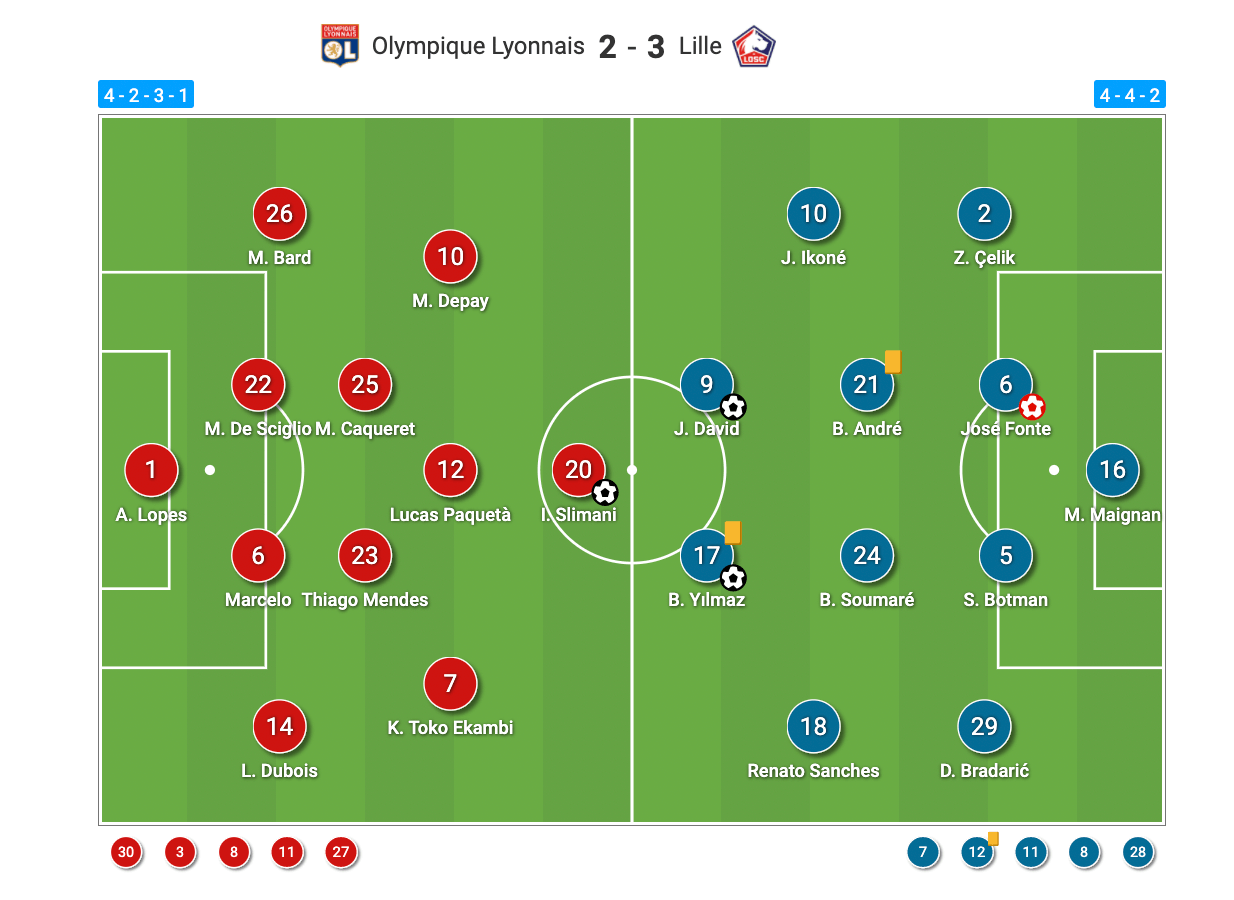
Hosts Lyon lined up in a 4-2-3-1 shape for this game. Anthony Lopes started in goal, with a back-four in front of him consisting of left-back Melvin Bard, right-back Léo Dubois, right centre-back Marcelo and loanee left centre-back from Serie A side Juventus Mattia De Sciglio.
Maxence Caqueret and Thiago Mendes played in the holding midfield positions in front of the back-four, with Lucas Paquetá playing in the ‘number 10’ position. Memphis Depay played on the left-wing with Karl Toko Ekambi on the right, while Islam Slimani completed Les Gones’ starting XI, playing in the centre-forward position.
Bruno Guimarães took Paquetá’s place in the 64th minute, Maxwel Cornet and Tino Kadewere replaced Slimani and Toko Ekambi, respectively, in the 73rd minute, and the duo of Djamel Benlamri and Houssem Aouar were introduced as Lyon’s final substitutes in the 79th minute, replacing Dubois and Caqueret, respectively.
As for the visitors, Lille lined up in their regular 4-4-2 shape for Sunday’s fixture. Highly-rated Mike Maignan started between the sticks, with right-back Mehmet Zeki Çelik, left-back Domagoj Bradarić, right centre-back José Fonte and left centre-back Sven Botman making up the back-four in front of him.
Jonathan Ikoné started at right-wing while Renato Sanches started on the left, with Benjamin André playing at right central midfield and Boubakary Soumaré playing at left central midfield. The two goalscorers, David and Yılmaz, started up front, completing Les Dogues’ starting XI.
As for Lille’s substitutes, left-back Bradarić was the first to make way, with Reinildo Mandava taking his place from the beginning of the second half. Jonathan Bamba then replaced André in the 61st minute, with Sanches moving from left-wing to take the latter’s place in midfield and Bamba taking over on the wing. Luiz Araújo and Xeka were introduced in the 73rd minute in place of Ikoné and Sanches, respectively, while Yusuf Yazıcı, who assisted compatriot Yılmaz’s game-winning 85th-minute strike, replaced David in the 80th minute as Lille’s final substitute.
Lille’s defensive tactics
When playing in their usual 4-4-2 shape, Lille tend to defend in a very horizontally compact mid-block. During the opposition’s build-up, their strikers tend not to press the centre-backs on the ball. Instead, they sit closer to the central midfielders in the next line to block off the passing lanes between those players and the centre-backs.
Meanwhile, their wingers tuck in very narrow to congest space centrally and their central midfielders sit slightly deeper. This creates a tight, hexagon shape centrally which is designed to prevent the opposition from playing through the centre.
These are the defensive tactics that have helped Lille to get into their league-leading position with the best defensive record in terms of goals conceded of any side in Ligue 1. As they say, if it ain’t broke don’t fix it, and this is exactly how Lille played during Lyon’s build-up play on Sunday.
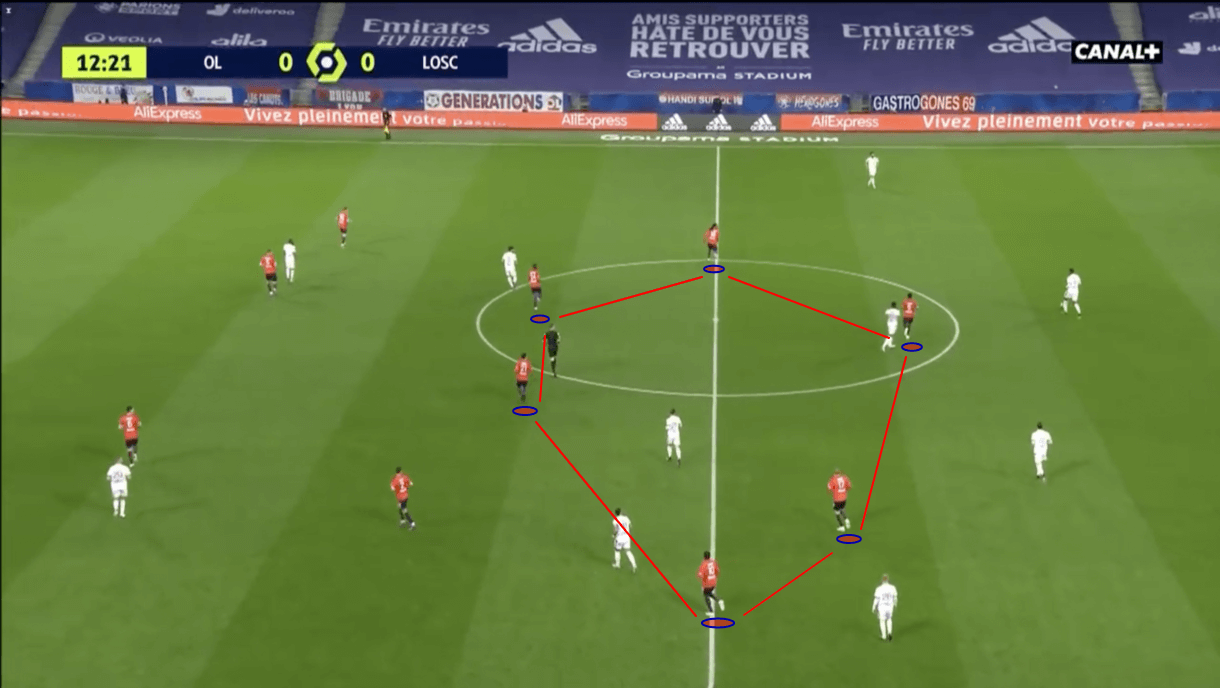
We see Lille’s 4-4-2 defensive shape, with their strikers positioned deep to try and prevent Lyon from playing through the centre, the wingers tucking in narrow and the holding midfielders sitting slightly deeper, forming a hexagon, in figure 2.
This was somewhat effective at making central progression more difficult than it otherwise would have been for Lyon, but Les Gones were prepared for Lille to use these tactics and had plans of their own that helped them to build out from the back despite Lille’s solid shape, which we’ll analyse in greater detail later in this tactical analysis piece.
Obviously, by sitting so horizontally compact and congesting the centre, Lille gave up plenty of space out wide for Lyon to potentially play around them. However, that is where their pressing comes into play.
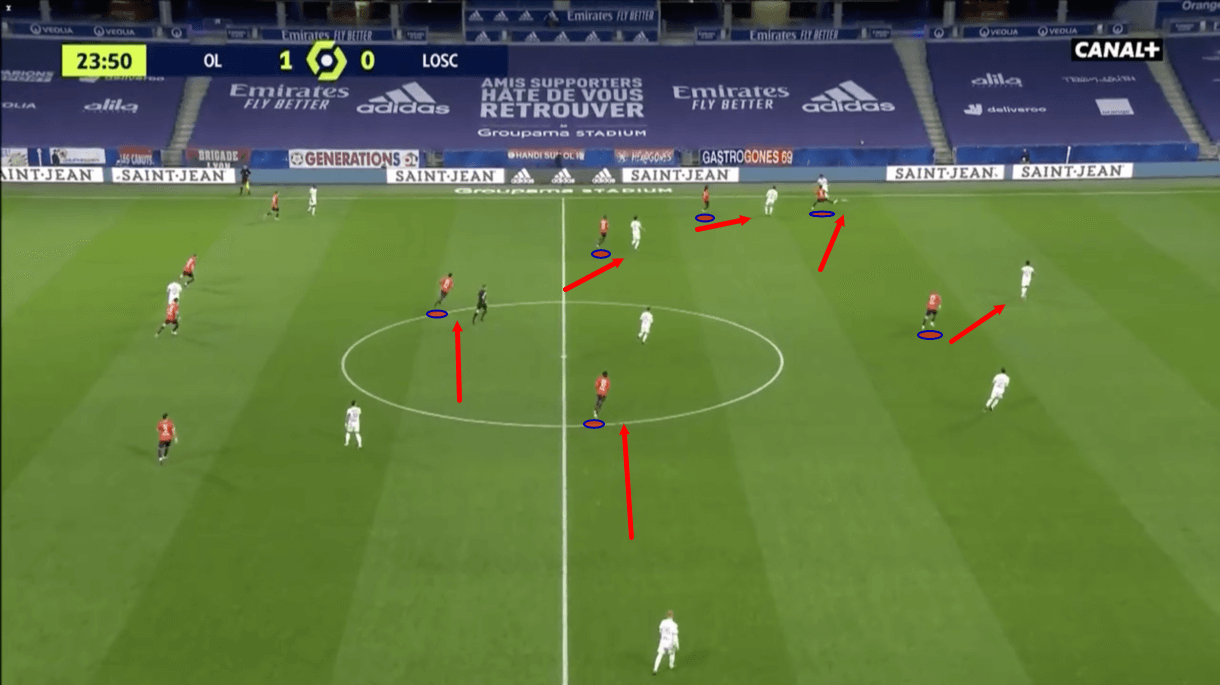
In figure 3, we see one occasion where Lyon did play the ball out wide. The opposition receiving the ball in this position is generally a big pressing trigger for Lille, which was the case in Sunday’s game. So, when Lyon did play the ball out to their full-back or even the centre-back if they were positioned out wide, Lille’s press, led by their strikers, became more aggressive.
The near-side striker presses the man in possession, with the near-side winger pressing his nearest forward passing option on the wing, the near-side central midfielder advancing to mark the holding midfielder that the striker vacated, and the far-side striker advancing to mark the nearest sideways passing option for the man in possession, which we see in action in figure 3. The rest of Lille’s team also then shifts over to this wing to prevent large gaps from opening up between players.
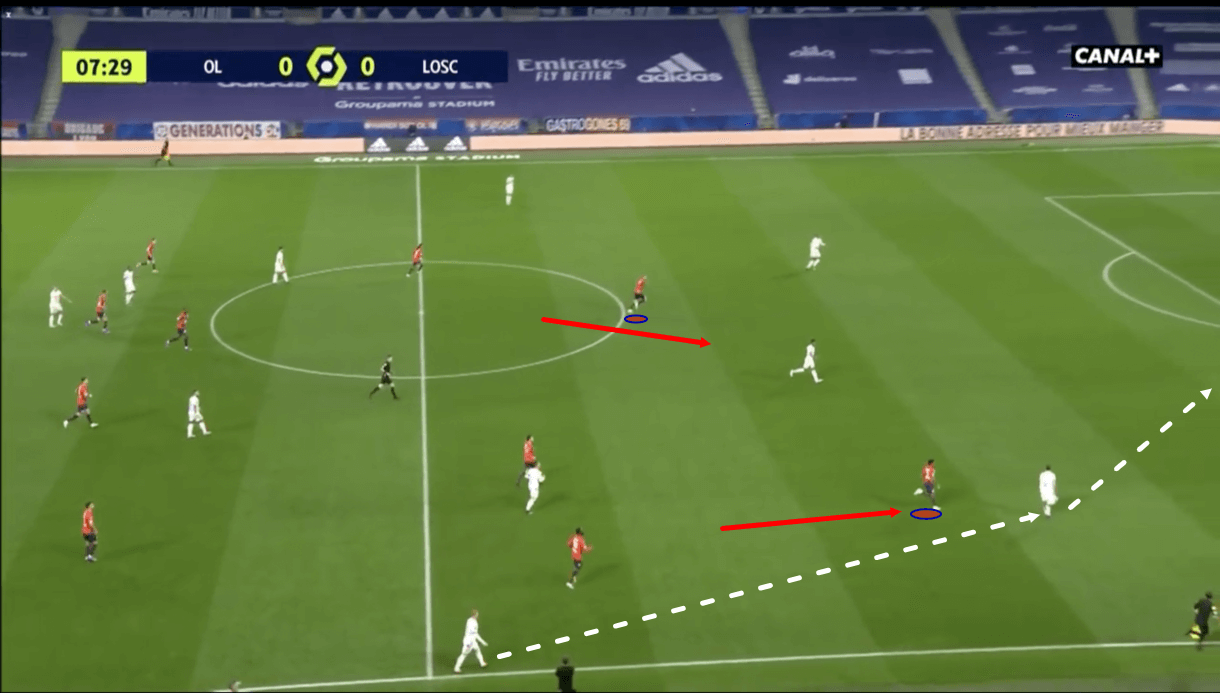
Lille also pressed more aggressively when Lyon played the ball backwards, which figure 4 shows. Just before this image, Lyon left-back Bard was in possession, attracting pressure from Lille’s winger, with the rest of Lille’s defensive block following suit. Bard then plays the ball backwards to the left centre-back, De Sciglio, but the pressure doesn’t ease up here, as it’s also common to see Lille spring into defensive action upon the ball being played backwards by the opposition.
Similar to before, the striker leads this press, with his strike partner advancing to prevent the pass to the nearest centre-back option.
Lille press when the ball is played out wide because the player in possession in this area has a limited amount of the pitch to play with due to the sideline beside him. Lille take advantage of this situation by pressing more aggressively, marking the wide man’s nearest passing options and trying to force a turnover either by tackling the player, intercepting his pass, or forcing him to play a risky long ball for Les Dogues’ deeper players to attack.
Lille press when the ball is played backwards because this is often a good opportunity for players to advance, closing off forward passing options before the man on the ball receives the pass. Pressing the ball-receiver aggressively can be effective here as he has a limited amount of time to make a decision with his options being closed off around him and a man pressing to worry about while pressing this in certain ways can force the ball onto his weaker foot or force him to receive the ball in such a way that the only real passing option is across to the nearest centre-back, which Yılmaz covers, or back to the goalkeeper, which is where the ball goes as figure 4 moves on. Lille can then repeat their movement, pushing up again to mark the goalkeeper’s nearest passing options and forcing him long.
Les Gones’ pressing was effective at forcing turnovers throughout this game, some of which came in dangerous positions. Their second goal of the game came from a situation where pressure was applied and an error was forced. This goal tied up the game so was an undeniable turning point engineered through Galtier’s tactics.
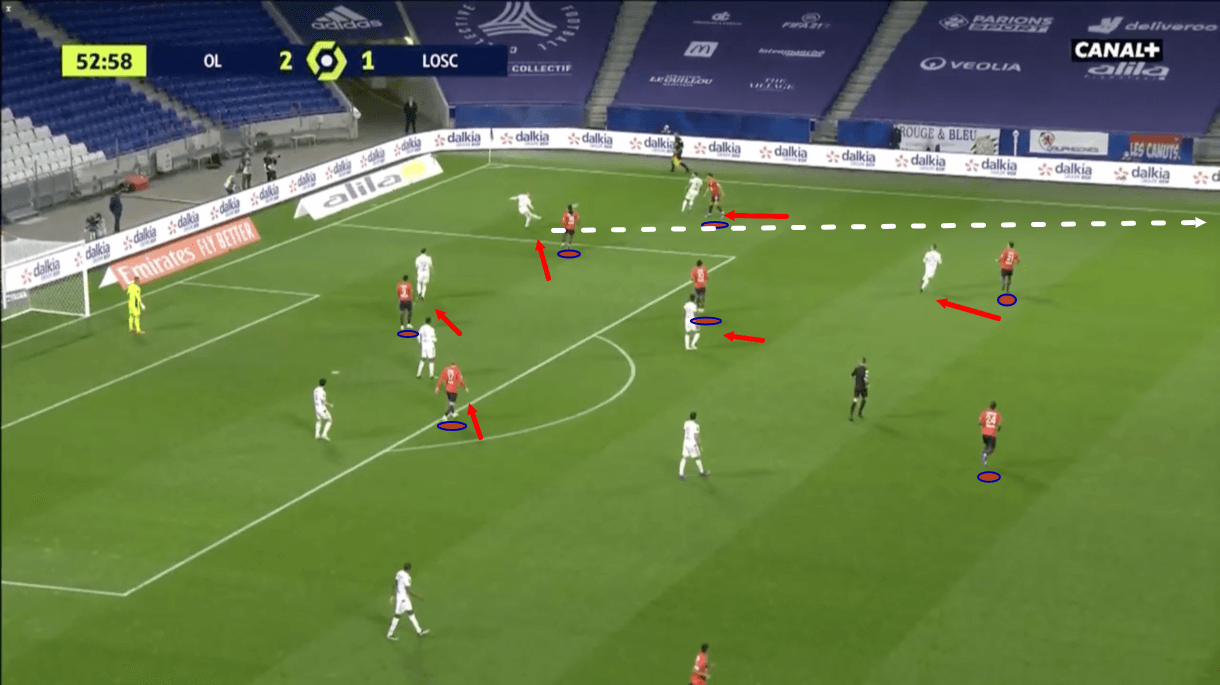
Lille’s defensive tactics remained fairly consistent throughout the 90 minutes on Sunday but they did counter-press more in the second half, as they attempted to make their comeback. Figure 5 shows an example of this counter-pressing from the second half.
Lille committed many men to their attack, and to limit the time Lyon’s backline had to pick out their pass and start a counterattack, they were organised to ensure that all the nearest passing options were closed off, the man on the ball was pressed aggressively by one of Lille’s pacey attackers and in this particular example, they forced a risky long ball that didn’t pay off, which provides one example of the benefits to Lille’s counter-pressing that helped them to gain more control of the game in the second 45 minutes.
Lyon’s offensive tactics
Lyon ended up losing this game but they were two goals to the good at one point, going into half-time with a 2-1 lead. So, how did Les Gones manage to put two past Ligue 1’s most solid defence in just over half an hour of playing time?
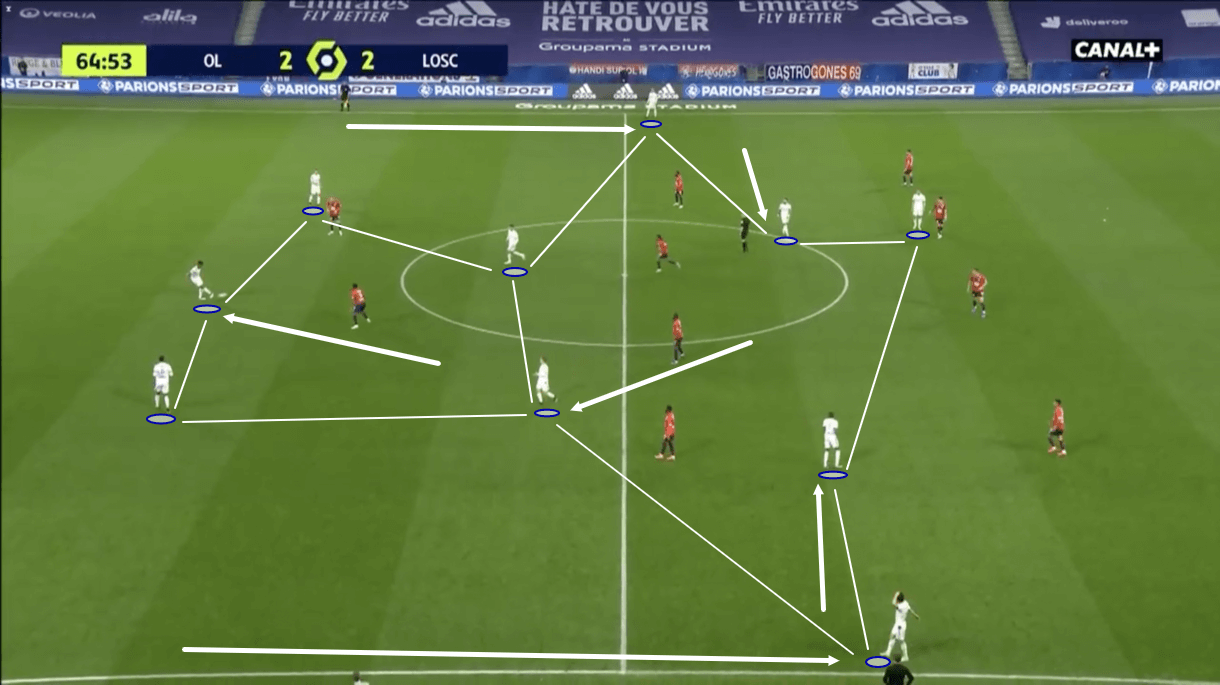
While Lyon set up in a base 4-2-3-1 shape, which they primarily used when defending deep, they generally attacked in a 3-4-2-1 shape, which can be seen in figure 6. To form this shape, one holding midfielder, Mendes, dropped deep, splitting the centre-backs. The ‘number 10’ dropped into his vacated holding midfield position, the full-backs advanced to provide the width in attack and the wingers came inside to occupy the half-spaces.
Mendes’ movement from holding midfield to centre-back was key for Lyon in building out from the back to beat Lille’s solid defensive structure. PSG used similar tactics in a recent clash with Les Gones to great effect. This movement helped Lyon to get Mendes, an excellent progressive passer with great composure, on the ball despite how Lille were set up to prevent passes from the backline into midfield – Mendes’ base position.
We know that Lille’s strikers don’t press very aggressively most of the time as a result of these tactics and the opposition centre-backs generally have plenty of time and space on the ball, as Lyon’s did. Mendes dropped deep to join the centre-backs during the build-up and Lille’s strikers didn’t follow him, as this would open a pass from the backline into midfield, which Galtier’s side are strictly set up to prevent. So, Mendes had as much freedom as the centre-backs.
This helped Lyon to play past Lille’s forwards, firstly, because they now had a 3v2 numerical advantage over Lille’s strikers with their centre-backs, making it easier for them to create passing angles from centre-back into more advanced positions, and secondly, because Mendes offered more quality on the ball, in terms of long passing and progressive passing, than either Marcelo or De Sciglio, and he was able to find and pull off passes that others wouldn’t. Mendes was also able to play one-twos with players ahead of him to play around Lille’s forwards and into midfield, so this tactical move was a wise one from Garcia.
Mendes and the centre-backs could find Paquetá and Caqueret in midfield thanks to those players’ impressive ability to lose their markers and find space as well, which also aided Lyon’s ball progression. As well as being excellent at finding space, these two players don’t tend to need a lot of space, due to their impressive agility and dribbling quality. Both of those men carried the ball forward from midfield on several occasions during the game, bringing Lyon into the final third, so we can also see clear benefits to these tactics from Lyon in that regard.
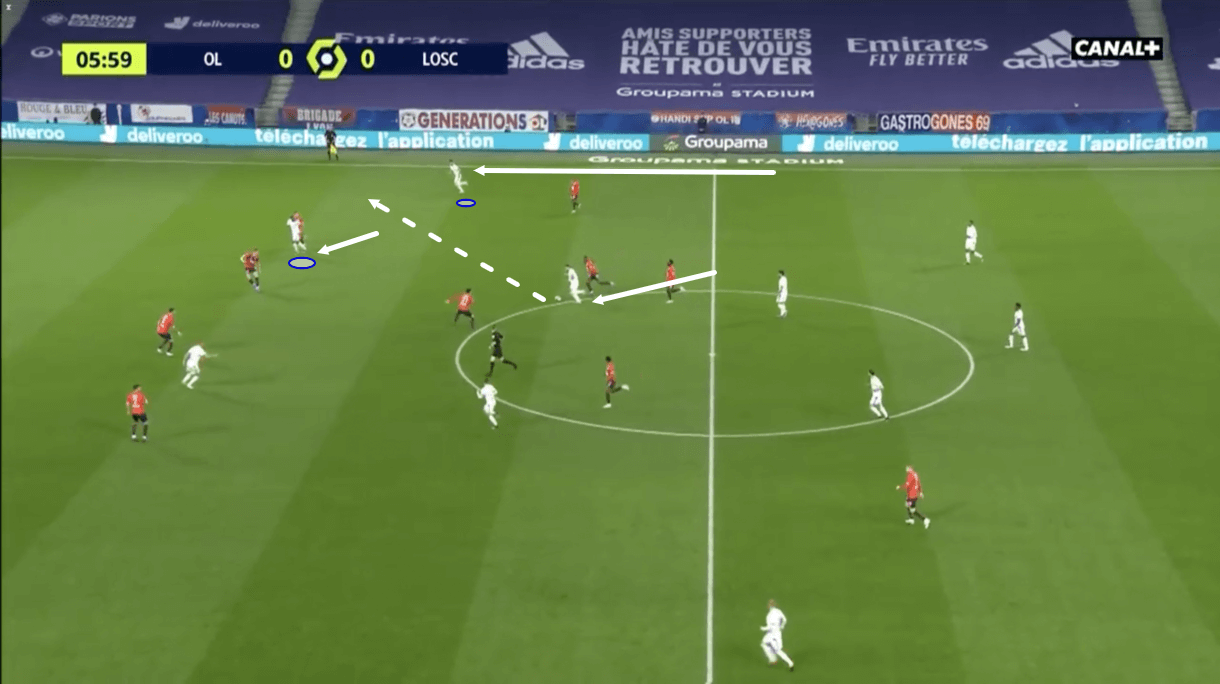
As for the movement of the full-backs and wingers, figure 7 shows one example of how this fit into Lyon’s attacking tactics successfully. Here, as Toko Ekambi moved inside, Lille’s left-back Bradarić followed him, creating space out wide for overlapping right-back Dubois to exploit. Dubois is a dangerous crossing threat and this helped Garcia’s side to make use of this skill of his.
If Depay and Toko Ekambi were not marked closely enough, giving them room in the half-spaces is equally as dangerous, as both men are very good at linking up with teammates in tight spaces with quick passing and movement to create chances. Additionally, both men, especially Depay, are excellent playmakers, so they’re not the ones you want to find space in these positions.
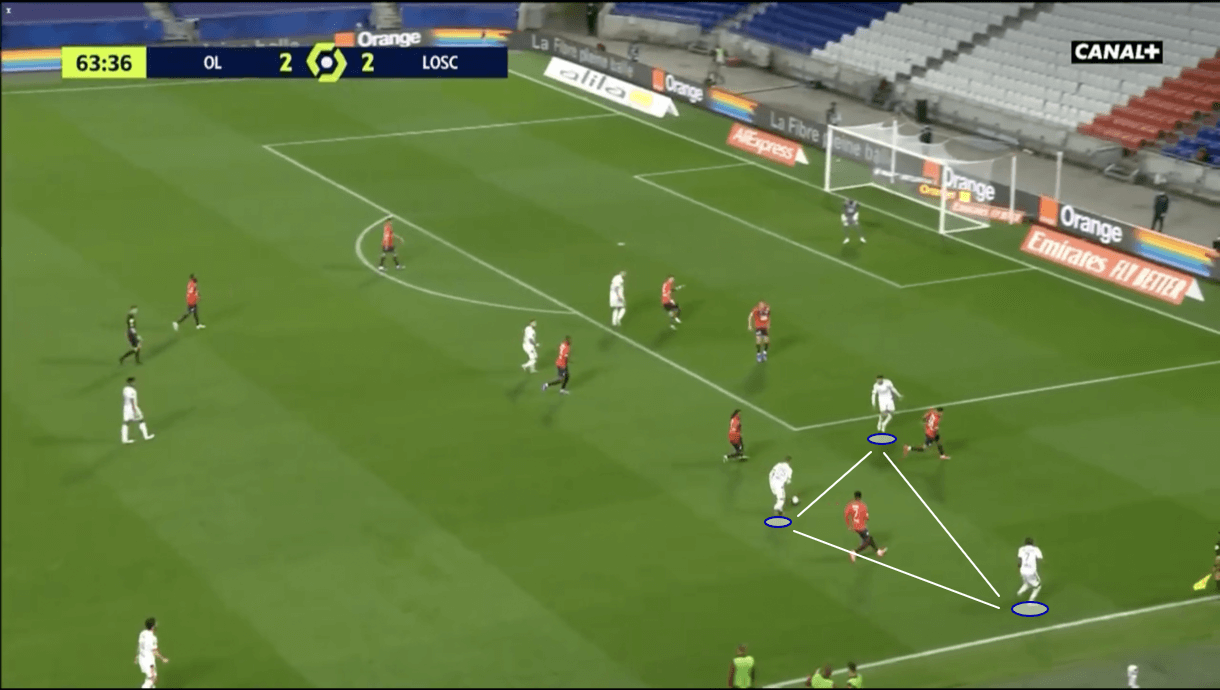
Lyon enjoyed a lot of freedom down the flanks thanks to their tactics, especially during the first half, with their first goal coming from the right-wing. They made a conscious effort to overload the wings inside the final third during the game, which helped them to cause Lille lots of problems. Figure 8 shows one example of the wide triangles that were a staple of Lyon’s tactics during this fixture. Some three-man combination of the winger, the full-back, a midfielder (the near-sided central midfielder or the ‘10’) and the striker would combine to create wide triangles like this to overload Lille out wide.
Les Dogues found it difficult to deal with this and thanks to these intelligent offensive tactics, Lyon managed to break into Lille’s box via some quick passing and moving in the wide areas on several occasions in this game. When they did manage to break into the box via the wing, whichever one of the trio got played through usually headed for the byline, from where he would play a low, cut-back cross into the box where there would usually be at least two or three attackers waiting.
In the second half, Lille managed to prevent Lyon from breaking through via the wings more, as they got tighter and shifted over to the wing more, closing the space around the triangle. Lyon reacted to this by switching the play from this position to the opposite wing, where there was usually a free man, typically the full-back, out wide waiting. Lille would then have to shift across to the other wing quickly to prevent this player from breaking into the box easily, and Lille were generally good at doing this.
Lyon focused a lot on trying to exploit Lille in transition as well on Sunday. As mentioned previously, Lille committed plenty of men forward in attack, especially in the second half. This did leave some space open at the back for Lyon to exploit despite Lille’s effective counter-pressing, which they managed to do on some occasions. Additionally, as we’ll discuss in greater detail later on in this tactical analysis, Lyon deployed some effective pressing of their own that helped them to force plenty of turnovers high up the pitch during this game.
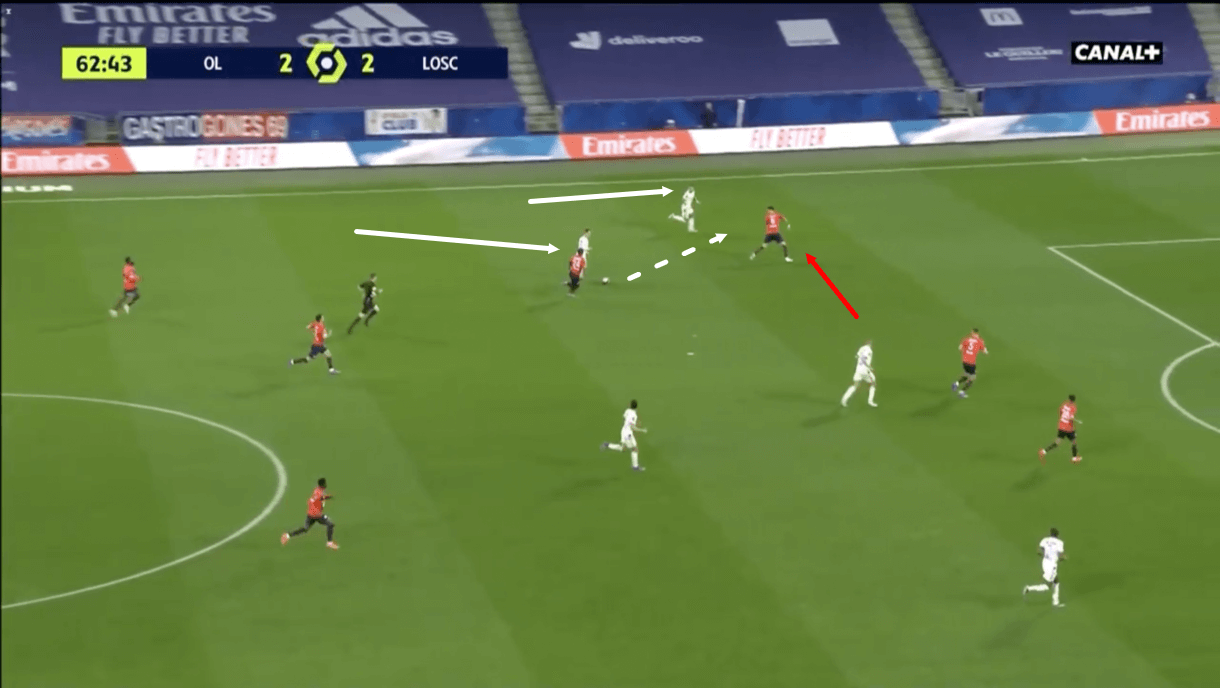
Due to their role in attack, Lille’s full-backs were often caught out of position on Lyon’s counterattacks and Les Gones tried to exploit this by, once again, making use of the wings. In figure 9, we see one occasion where they countered and managed to get Depay 1v1 with right centre-back Fonte out wide.
Lyon’s centre-backs aren’t the quickest nor are they the most agile, so it was intelligent of Lyon to exploit the full-backs being out of position by isolating the wingers 1v1 with the centre-backs in this position where they wouldn’t be the most comfortable. As play moves on here, Depay storms past Fonte, heading for the byline in typical Lyon fashion from this game, before playing a low cross.
As Lyon dragged Lille’s centre-backs apart like this, it did create plenty of space between them which could potentially have been exploited but this isn’t something that Lyon managed to do during the game very much, so perhaps that is another area they could’ve looked at exploiting, particularly on the counter, but it’s difficult to fault the logical gameplan they did go with in transition to attack.
Lyon’s defensive tactics
As mentioned, Lyon generally defended deep in their 4-2-3-1 shape, but they didn’t attack with it. They also didn’t press with a 4-2-3-1, as we’ll analyse in this section.
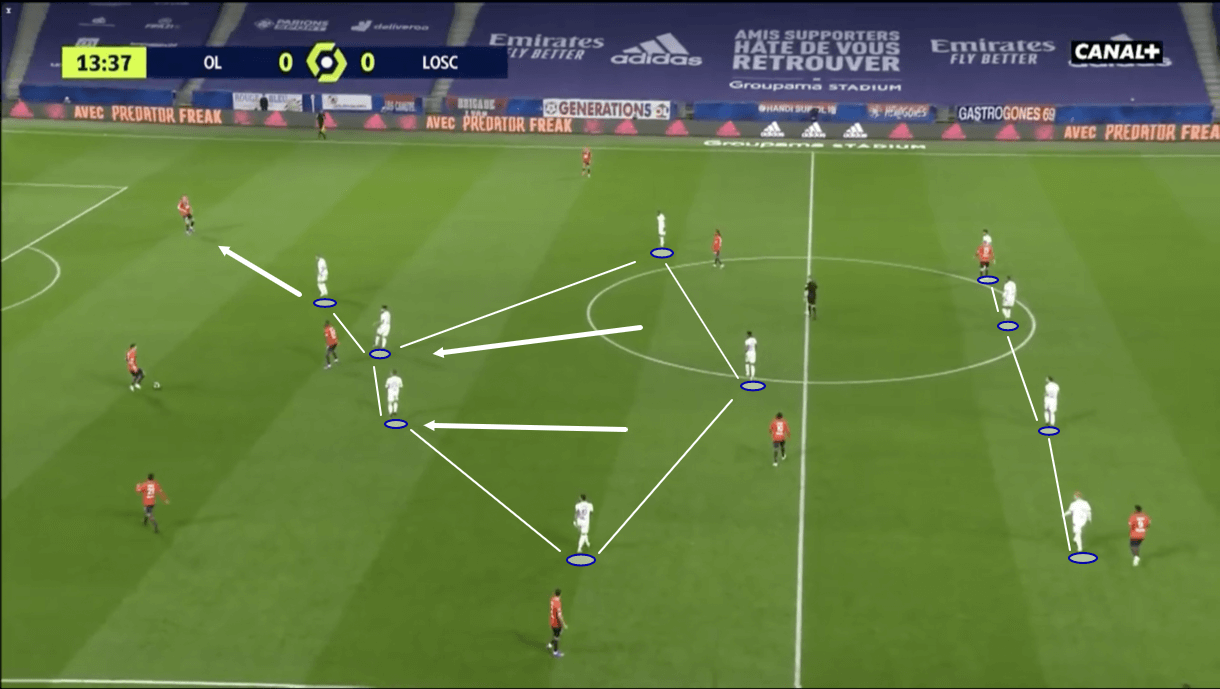
Lyon lined up with a 4-1-4-1 shape when defending high, with Mendes occupying the holding midfield position while Caqueret and Paquetá formed a central midfield duo just in front of him, which we can see here in figure 10.
However, looking at the midfield, it’s clear that Caqueret and Paquetá are in even more advanced positions, making this shape look more like a 4-3-2-1. This is because within Garcia’s defensive tactics for this phase of play, these two players were tasked with marking Lille’s central midfield duo very tightly and both men tended to sit very deep, particularly in the first half, as we’ll discuss at greater length later.
The purpose of this was, similar to Lille’s defensive tactics, to prevent the opposition from playing through midfield, though Lyon went about trying to achieve this goal in a very different way to Lille, and did so with less success, again, as we’ll go on to examine in further detail.
As these central midfielders advanced higher up the pitch, Lyon’s wingers tucked in to give some support to Mendes, who was left alone in central midfield, resulting in this 4-3-2-1 shape forming.
Figure 10 also shows us another prominent aspect of Lyon’s defensive tactics from Sunday’s game: while defending high, they made an effort to effectively cut the pitch in half. We see this through the positioning of Slimani, who isn’t sitting centrally but is slightly to the right of centre, threatening to press Lille’s left centre-back immediately if the right centre-back passes to him while cutting off the passing lane between the ball-carrier and the full-back on the opposite wing.
Lyon made an effort to cut the pitch in half and try to force Lille to play on one particular side of the pitch because, again, similar to Lille but with different execution, they wanted to force their opponents to play out to the wing, which was a pressing trigger for them.
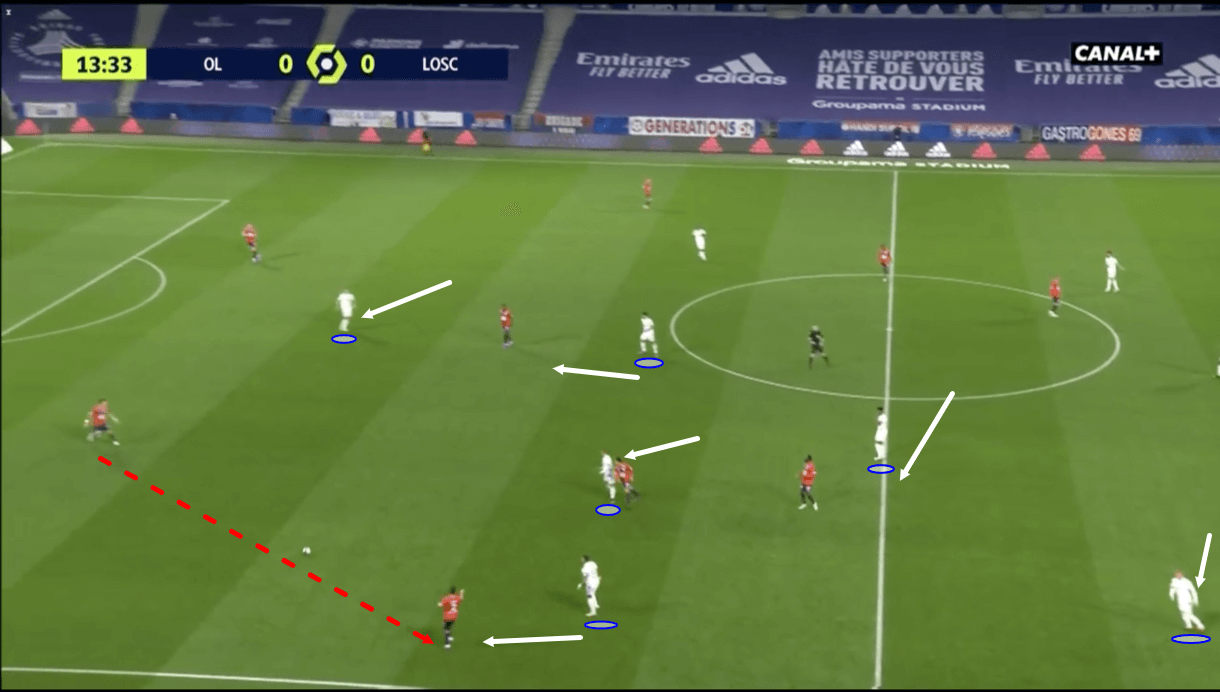
Figure 11 shows an example of one occasion where Lille did play the ball out wide, leading to Lyon’s press becoming more aggressive. Here, Lyon’s right centre-back played the ball to the right-back, with Slimani and his teammates cutting the pitch in half for the right centre-back. The pass to the right-back was left open but Lyon did so intentionally, as they wanted the ball played into this position where they increase their pressing intensity due to the full-back having a limited amount of the pitch to play with, similar to Lille.
As well as the near winger pressing the opposition full-back on the ball, Lyon’s near full-back and the central midfield trio all cut off potential passing options to make life even more difficult for the man on the ball, and he is ultimately forced to play the ball back to the right centre-back, having been prevented from progressing play for Lille by Lyon’s press.
These pressing tactics were particularly effective at stifling Lille’s build-up in the first half, while they also helped Lyon to force some turnovers in dangerous positions during the game, with Les Gones creating some goalscoring opportunities from those instances.
Lille’s offensive tactics
So, how did Lille set up offensively to ultimately overcome Lyon and their defensive tactics? And what tactical changes did Galtier implement to help his side turn things around in the second half? In this section of analysis, we’ll provide some answers to those questions by examining Lille’s tactics in build-up and how they changed throughout the game, as well as what Lille did when they entered the final third, with a particular focus on how they got the best out of match-winner Yılmaz.
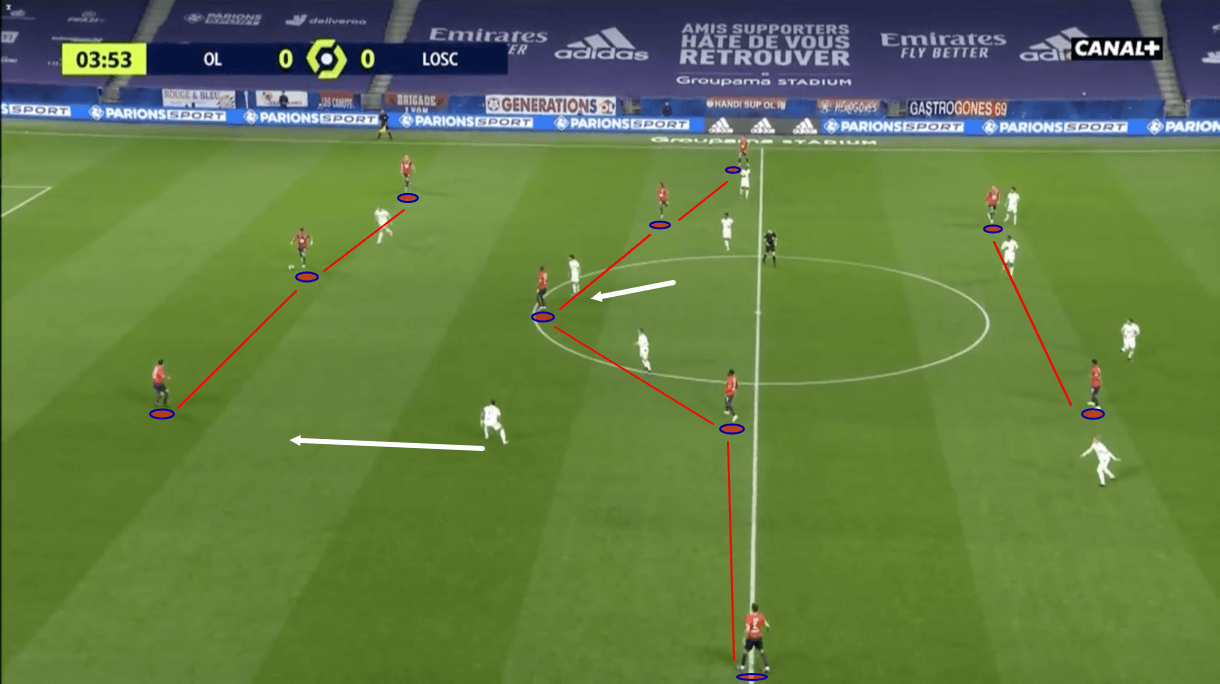
Firstly, figure 12 shows how Lille looked during the build-up a lot of the time in this game – a 3-1-4-2 shape. To form this shape from their 4-4-2, André dropped from his right central midfield position to this right centre-back position, allowing Fonte to become a central centre-back. Meanwhile, both full-backs advanced to provide the width in attack and both wingers shifted inside to occupy the left and right central midfield positions just in front of Soumaré at the holding midfield position.
By moving in this way, Lille got to take advantage of the crossing threat that both full-backs provided, while allowing their wingers, Ikoné and Sanches, to occupy central positions, where they are both more than comfortable and capable of finding space and progressing play, either via passing or dribbling – these two were good at finding space and using that ball-progression ability to Lille’s advantage in this one, with the free-kick that led to Lille’s first goal coming from one such situation. Lyon usually press in a 4-4-2, and by shifting into this shape while building out from the back, Lille would also have a 3v2 advantage versus Les Gones’ forwards.
Additionally, this allowed Lille to take advantage of André’s ability to progress the ball forward despite Lyon’s central midfielders being set up to mark Lille’s central midfield duo tightly. By dropping so deep that he became the right centre-back, André lost his marker. Lille’s movement, as a team, to drop André to right centre-back, Çelik to right-wing and Ikoné to right central midfield caused a dilemma for Lyon’s midfielders but Lyon’s priority while pressing is always to prevent the opposition from overloading them centrally and if Caqueret followed André all the way upfield, then Lille could’ve overloaded Lyon centrally.
However, even by getting caught in between the Lille players as a result of their movement, Lille had an opportunity to build through the centre thanks to their tactics in build-up which freed up the wingers when they moved inside on plenty of occasions.
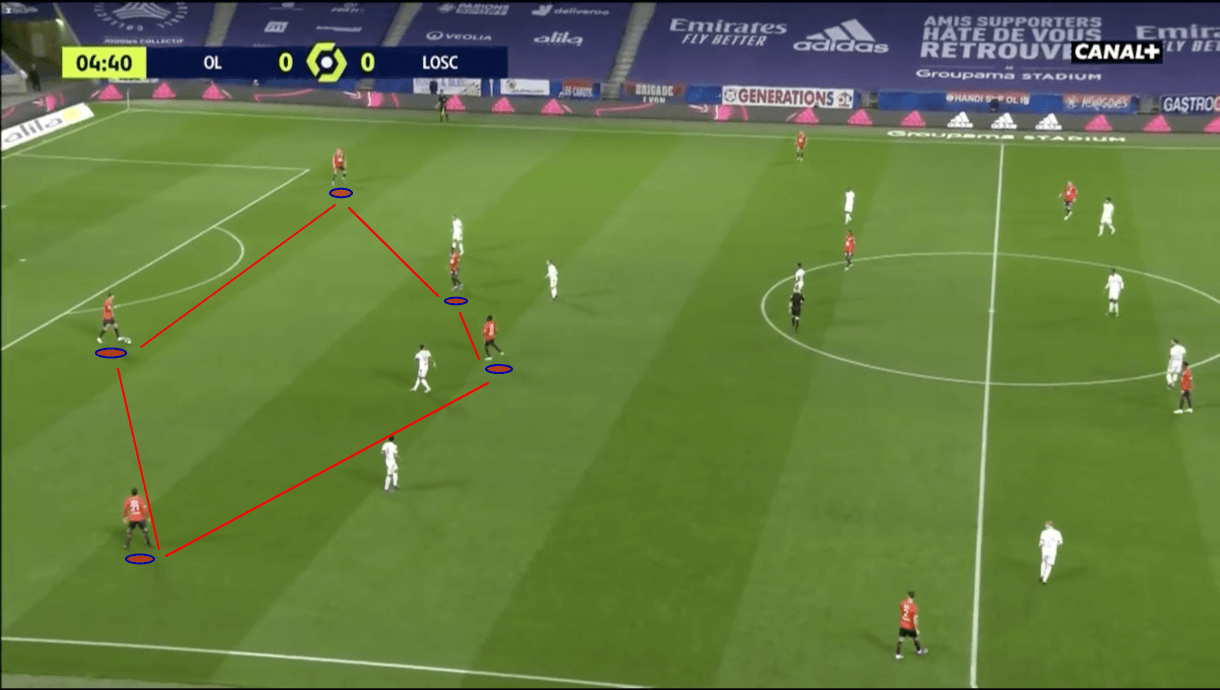
In figure 13, we see Lille in a 3-2-3-2 shape, which they utilised a lot in the first half of Sunday’s game during the early stages of build-up. This saw the back-three, including André, the holding midfielder and one of the two new central midfielders, in this case, Ikoné, drop deep, creating an overload in this area. A lot of the time in the first half, Lille built up very patiently, with plenty of short passes at this stage, seemingly to draw more pressure from Lyon to create more space for Lille’s attackers further up the pitch.
However, Lyon were very disciplined with their pressing in this game, and as they pressed with just one striker, as opposed to two like they normally would, Lille had a two-man advantage at the back instead of just one, which was excessive, giving them plenty of lateral passing options at the back but not enough progressive passing options, as Lyon occupied central midfield heavily, preventing progression through this area, and didn’t commit too many men upfield pressing, generally keeping at least their back-four and Mendes in their base positions. This hindered Lille’s build-up play.
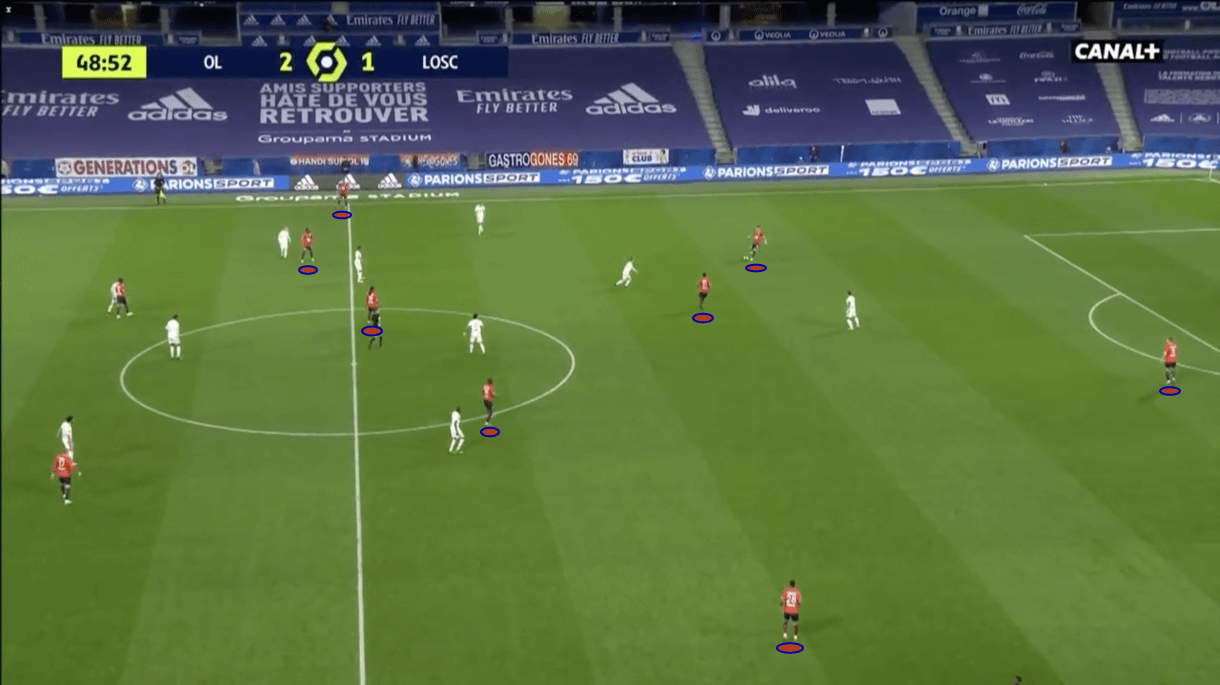
In the second half, however, Lille made some changes to their build-up play which were risky but had a positive impact. In figure 14, we see an example of Lille’s shape during the build-up in the second half. We can see that they placed far fewer men in deep positions, positioning more bodies further up the pitch. As well as that, André dropped into the right centre-back position less in the second half, as without André and Soumaré dropping deep, Lille’s centre-back duo only had one forward pressing them, so would have a 2v1 advantage.
As a result, they switched to their three-back shape less, with either André or Soumaré now occupying the holding midfielder role and the other staying further upfield, increasing Lille’s presence centrally.
This switch also incentivised Lille to play more forward passes, as they now had fewer numbers at the back and more numbers upfield. The holding midfielder, though he was usually marked tightly, had an important role to play in ball progression as he acted as a wall for the centre-backs to bounce passes off, while attracting pressure from the Lyon midfielder marking them, helping the centre-backs to play around this player and continue progressing play upfield.
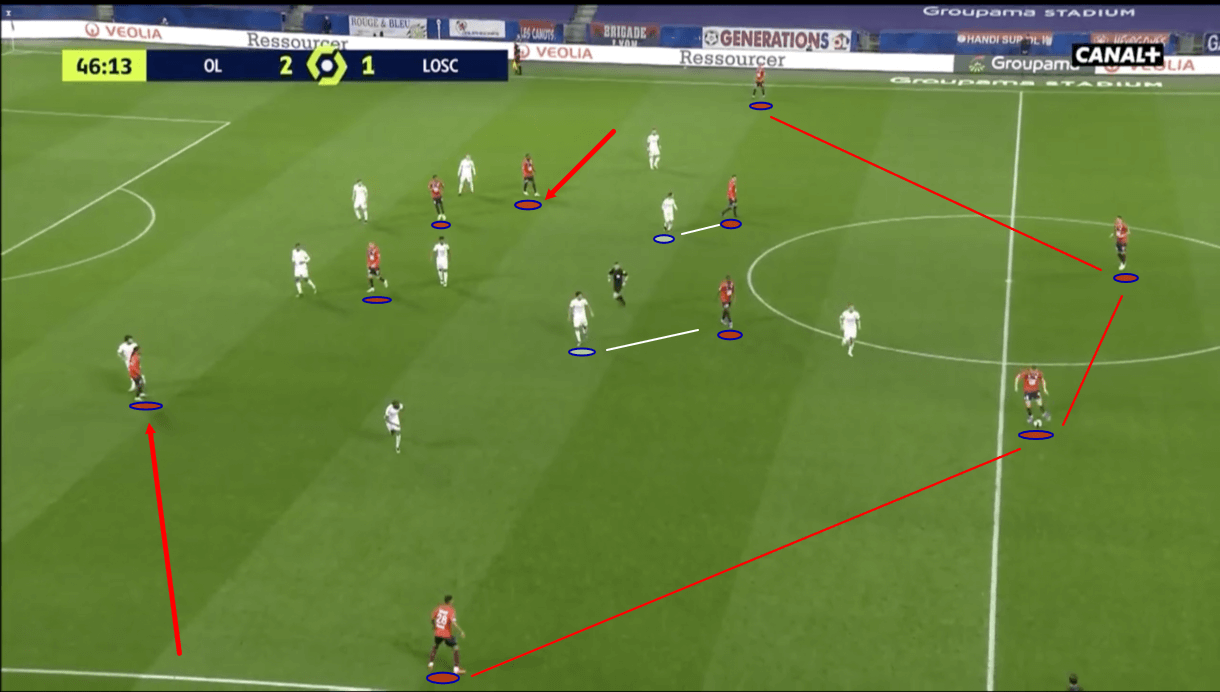
This helped Lille to form their final third 2-4-4 shape that we see in figure 15 more in the second half. Their wingers advanced into the frontline, with the central midfielders staying in position and the full-backs advancing. They piled pressure on Lyon thanks to these tactics as they helped them to build up easier and enjoy more possession in the opposition half, which is partly thanks to their counter-pressing as well.
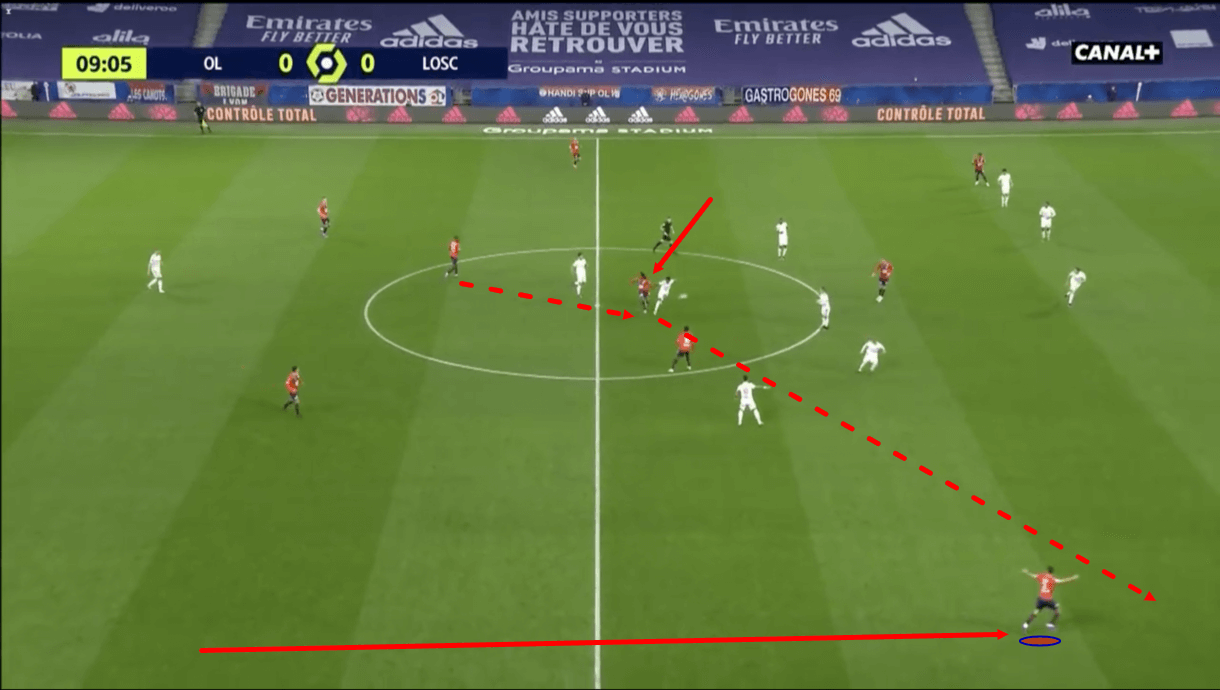
In figure 15 and now in figure 16, we see that when Lyon were defending deep they left a lot of space out wide for Lille to target, which they did via their attacking full-backs. The long-ball playing quality of Botman, Soumaré, André and Sanches was very useful in helping Lille to exploit this space. With Lyon defending very narrow and their full-backs only really pressing aggressively when the ball was already out wide, Lille’s attacking full-backs often had plenty of space and with some quality long passers in their squad, Lille were able to get the ball to the full-back in space before the Lyon full-back had come out from the back-four. This was effective in helping Lille to play into Lyon’s half and into the final third in Sunday’s game, as the full-backs did a good job of carrying the ball upfield after these long passes, which resulted in plenty of chances being created for Lille via these situations.
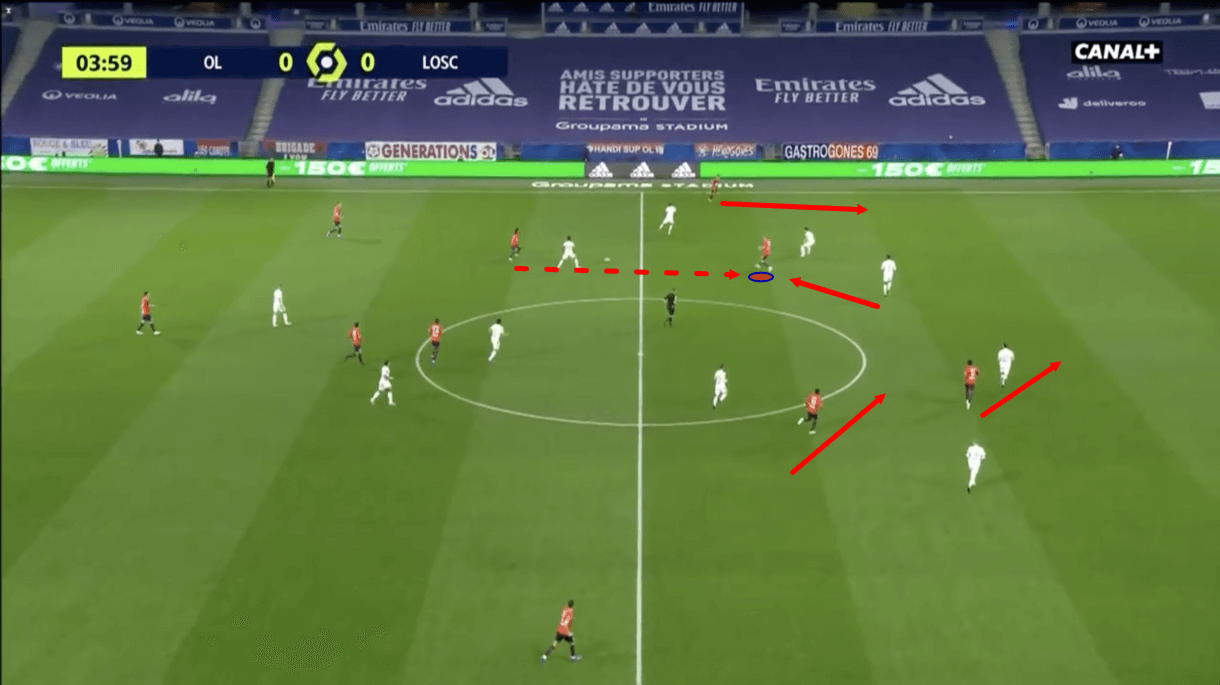
Yılmaz was very important in terms of his overall role within Galtier’s offensive tactics on Sunday. The 35-year-old provided an outlet for Lille’s deeper players to look for, with passes of all different lengths and heights via his positioning, movement and ability to hold up the ball and bring others into the game. In figure 17, we see an example, essentially, of how Yılmaz was used by his side when they were building up into Lyon’s half or when they were building into the final third.
Yılmaz is excellent at playing with his back to goal thanks to his ability on the ball and his size and strength which help him to hold off challenges from opposition defenders while attracting attention from them to create space for his teammates elsewhere, who he can then try and bring into the game.
Additionally, the Turkish forward didn’t just sit centrally to wait for the ball to be played into him, he moved into the channels and dropped off from Lyon’s backline to find space in between the lines from where he could impact the game by being a progressive passing option for Lille’s deeper players and someone for the attackers around him to link up with and play off of.
Yılmaz isn’t just hold up play, however, he has a dangerous burst of speed and thanks to his size and strength, it can be extremely difficult to dispossess him once he gets moving at pace. Lille tried to make use of this aspect of his game by playing long balls over the top against Lyon’s high line.
This was part of why they were so patient with their build-up at times to draw Lyon’s press upfield and it paid off in the 85th minute when a long ball from deep-lying playmaker and left centre-back Botman found the head of substitute striker Yazıcı, who knocked the ball in behind Lyon’s high backline, which has been a notable issue of there’s of late, for Yılmaz to run onto and ultimately slot the ball home.
So, the well-rounded veteran striker was pivotal to his side’s offensive efforts and thanks to how Galtier set his team up, they managed to get the best out of the 35-year-old.
Conclusion
To conclude this tactical analysis, all three of Lille’s goals in this inspired comeback clearly came directly as a result of Galtier’s tactical instructions, one from the inverted wingers’ finding space in their central role in between the lines, one from their style of pressing and one from the long balls in behind for Yılmaz to exploit Lyon’s high line.
Both sides had similar aims defensively but went about trying to achieve their aims in different ways, with Lille, whose defensive tactics have been the best in the league all season, proven right to stand by their off-the-ball gameplan, even if they did concede twice as a result of Lyon’s offensive efforts, particularly their wing play.


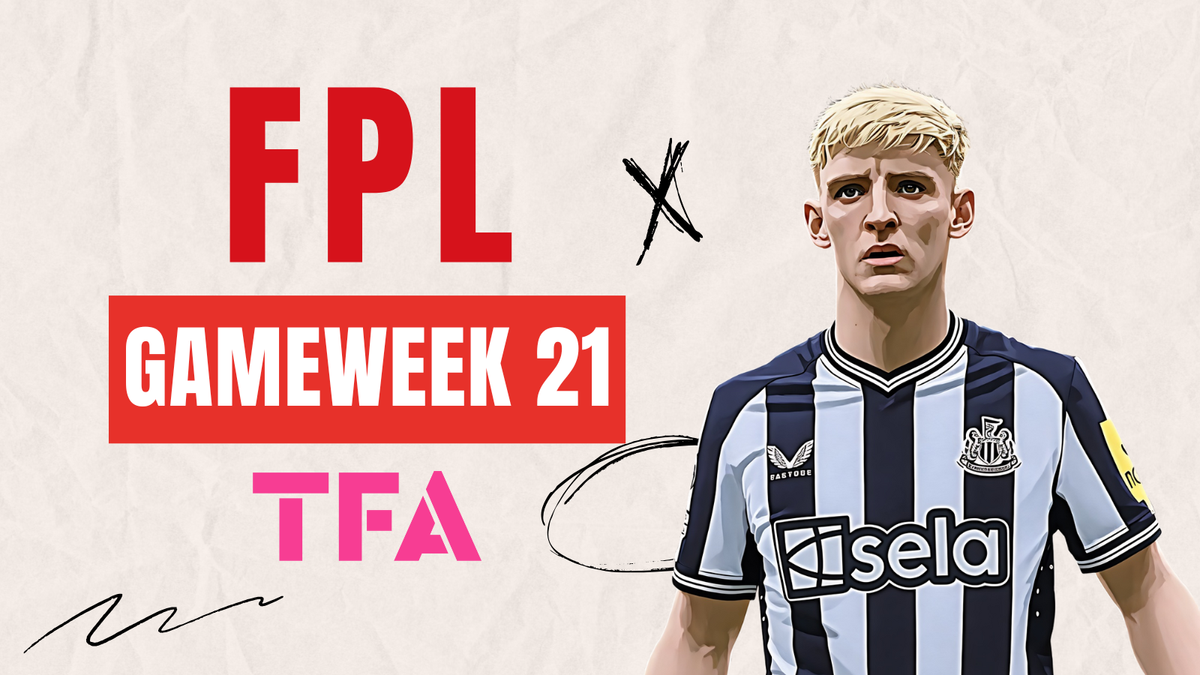

Comments